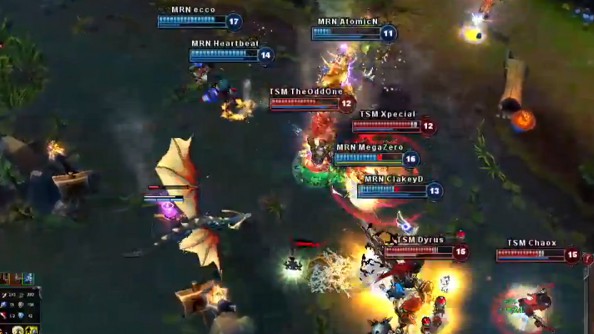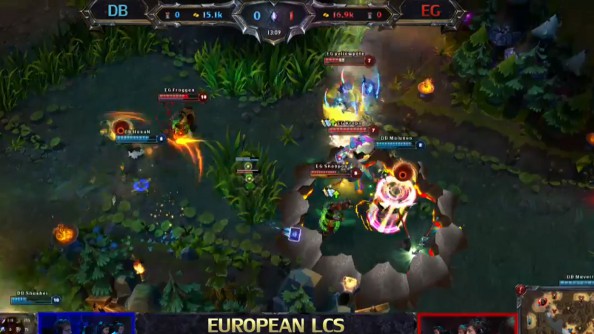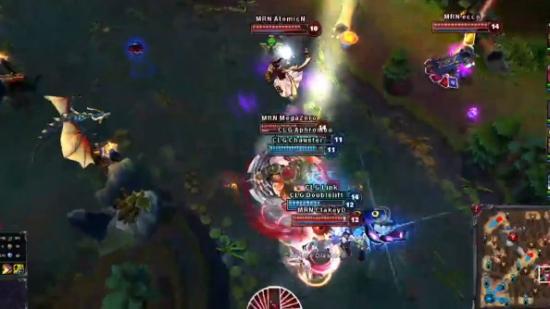The fourth week of the League of Legends Championship Series, the “Super Week” was a real test of whether or not League fans could get too much of a good thing. With 20 matches apiece in the North American and European divisions, following all the action in the LCS was a test of endurance and commitment. I was still catching up on matches throughout Monday, seeing what I’d missed while distracted by things like sleep and sustenance.
Super Week was a success: probably the single clearest sign that Riot have, indeed, struck upon a winning formula for eSports competition and broadcasting. Here are five lessons and highlights of Week 4, and what they spell for the rest of the season.
There are no bad teams, only bad closers
We saw a number of upsets and almost-upsets this week, particularly in the North American division. If you divided each League match in half somewhere between the laning phase and endgame, a lot of teams like MRN, Vulcun, and GGU would have won the first half against their favored opponents, but then gone on to lose the second half.
It goes to show two crucial facts about the LCS so far. First, it really is full of good teams who absolutely deserve to be there. Second, what separates the veterans from the newcomers is the former’s ability to stall games long enough for their experience and comfort with the volatile late-game to decide things. If you simply hang on long enough to get an ace in a big 5-on-5, you can rush the nexus and win the game before anyone has a chance to respawn. Right now, the veterans can rely on this against their less seasoned opponents.
What’s killing some of the younger teams right now is their hesitancy to risk a lead with aggression and split-pushing. When a TSM or a CLG is behind they’ll be more than happy to dance back and forth around their own inhibitor tower while their cooldowns finish and the gold difference becomes less important. It’s easy to lose a game with a risky 5-on-5 or to get picked apart when you get caught split-pushing, but for a lot of younger teams, letting the game go to 40 minutes or more is just as certain a death sentence. However, this week also gave us a lot of examples for ways teams can overcome their hesitancy and uncertain initiation.

The Vision Thing
Vision is always importantin League games, but this week it was crucial as teams like MRN took control of their matches through superior warding and heavy use of Oracles’ Elixirs to deny their opponents vision. Against TSM, in particular, this proved decisive, as the SoloMids fought a losing battle to retain map vision and burned precious gold trying to replace the wards that MRN were killing. At times both CLG and TSM were completely in the dark about what MRN was doing, and MRN’s aggressive timing and superior knowledge about their opponents’ positioning let them grab Dragons and Barons without any fear of nasty surprises.
The simple fact of Season 3 seems to be more variety in all things, and that includes timing and split-pushing. Where in Season 2 it seemed like baron and dragon attempts took place fairly predictably, so that teamfights were almost a certainty at Baron, now you see teams trying more things while Baron is out.
While TSM and CLG both tried to stall, but MRN finally hit on a solution to the problem. Cover the map in vision and clear enemy vision so that you can play with aggression and daring, without worrying about being caught out.
Light the lamp
Anyone who watched the Copenhagen Wolves upset Fnatic saw one of the best games in professional League of Legends’ short history. But one champion and ability that I saw consistently turning engagements and rescuing CW from Fnatic’s opportunistic play was Thresh and the Dark Passage. Time and again CW’s Martin “Deficio” Lynge yanked his teammates out of fatal traps, saving them both a death and the use of their Flash spell.
I would not be surprised to see this become an enormously popular champion with some of the struggling teams in LCS because of this ability alone. It addresses so many of the issues that are dogging team like the Wolves and MRN. Having Thresh nearby lets the carries play a little more boldly, and lets a team flirt with a teamfight initiation without completely risking control of the situation. In time I’m not sure Thresh will be as necessary, but the certainly helped the Wolves survive some dangerous battles with the first-place Fnatic team.
The EG curse comes to the LCS
EG had a disastrous week. They went from second place to fourth, and tumbled to a .500 record of 6-6. They got soundly beaten by Gambit, and also gave up victories to Dragonborns and Against All Authority. Since some of you League fans are new to Evil Geniuses, it might be time to start talking about The Curse.
The EG Curse is really shorthand for the fact that EG players have acquired a reputation for under-performing the moment they sign with the team. Of course, the EG Curse probably has more to do with Evil Geniuses’ habit of recruiting top teams and players after they’ve enjoyed a significant run of success. Streaks are rare and difficult to sustain, and so it’s not surprising you’d see relative declines in performance following EG’s acquisitions.

But in this particular case, it seems like there’s probably something else going on. EG is competing in the League of Legends tournament at the IEM World Finals in Cologne, against a stacked field of Asian and European LoL teams. It’s not hard to see why EG might have focused on these upcoming games instead of their Week 4 games. Couple that with the major strides we saw from teams like Against All Authority and Dragonborns, among others, and you have a recipe for a disaster.
Which means that a verdict on where EG stands has to wait until the end of this week, when the face a strong international field in a high-pressure environment. Remember that if EG are going to win the world title this year, these are situations where they really need to thrive.
The LCS is coming together beautifully
I had my doubts after the first couple weeks of the LCS. The newer teams didn’t always seem like they’d offer a challenge to the status quo, and one of Riot’s best broadcast teams, Jatt and Deman, were split across two different broadcasts on two different continents. The other casting teams were fine, but overall the production didn’t have chemistry. It was sluggish and a bit airless compared to the live tournaments Riot has produced.
That is no longer the case. The casting teams now have excellent chemistry and, more importanty, they’ve become so practiced that they are able to provide a terrific mix of analysis and commentary no matter how frantic the action. And this last week proved that they’re able to sustain quality broadcasts over extraordinarily long and grueling days. It helps, too, that the production team have gotten very fast at getting replays put together of key action, which is often crucial for understanding what is happening in those dense teamfights.
It helps that LCS games are increasingly closely-contested, and the newer teams have gotten over their early jitters and inexperience and are starting to look like viable contenders. The result is variety, entertainment, and production that leaves viewers with a deeper appreciation for League. Bring on week 5!
